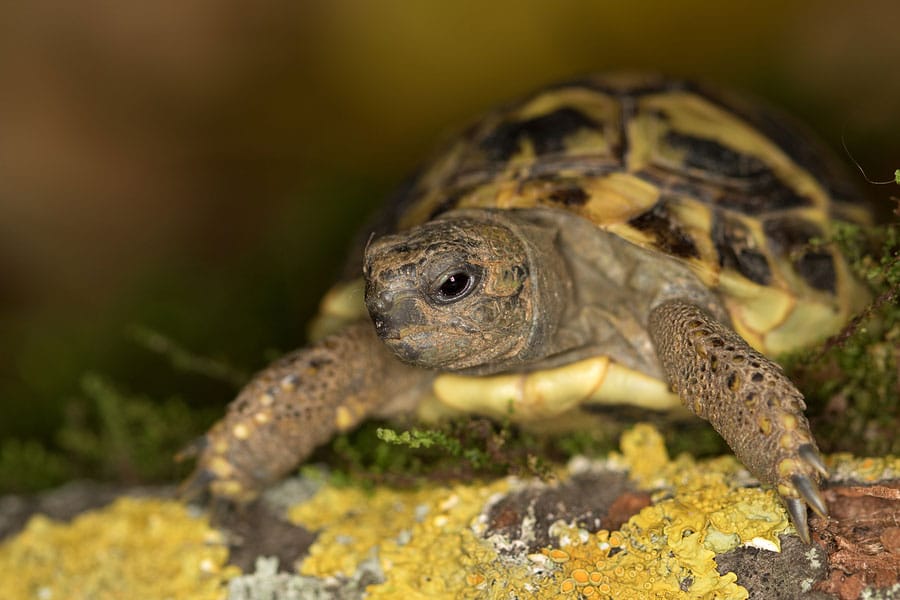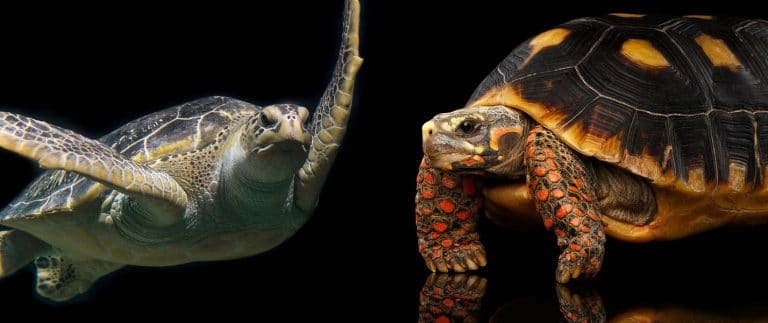Hermann’s Tortoise
Scientific Classification
| Kingdom: | Animalia |
| Phylum: | Chordata |
| Class: | Reptilia |
| Order: | Testudines |
| Suborder: | Cryptodira |
| Family: | Testudinidae |
| Genus: | Testudo (disputed) |
| Species: | T. hermanni |
| Binomial name: | Testudo hermanni |
Dating back 200 million years, to the origin of reptiles, the tortoise survived as a living fossil. The erstwhile population of these animals drastically diminished on account of the arbitrary destruction of their habitat and uncontrolled collection for exportation. All through the southern part of Europe, we see the testudo hermanni. In western Europe, one can see a good population of T. h. hermanni in the southern part of France, Sardinia, the eastern part of Spain, the Baleres Islands, Sicily, Corsica, and the central and southern parts of Italy (Tuscany). The population in the eastern region (T. h. boetgeri) dwells in Kosovo, Romania, Bulgaria, Greece, Albania as well as Serbia. However, T. h. hercegovinensis lives on the coasts of Bosnia and Herzegovina, Montenegro, and Croatia.

Habitat
The East Hermanns tortoise (T. h. boettgeri) is native of Bosnia, Yugoslavia, Romania, Bulgaria, Albania, Croatia, Macedonia, Hungary, Greece, southern Italy and Turkey. However, they prefer inhabiting rocky hill slopes with scanty vegetation, the oak forests of the Mediterranean and the arid lands.
Anatomy
The Hermann’s tortoises grow in tiny to medium sizes in the southern parts of Europe, their carapaces have striking yellow and black designs. Their upper jaws are a bit hooked, similar to other tortoises; they are toothless, and have strong horny beaks. Their limbs have scales of brown and gray color and at the tip of the tail there is spur (a horny spike). The subspecies T. h. boettgeri in the eastern part is far bigger than the T. h. hermanni of the western region, found in sizes of 28 cm (11 inches) lengthwise. A variety of T. h. boettgeri weighs up to 3 to 4 kg (6 – 9 lb)
As a Pet

Housing
A secure and safe outdoor habitat in a sunny area with plant varieties of edible weeds, some Bermuda grass and wild flowers is an ideal habitat. Rocky places for hiding, bushes, and an exposure area for basking are necessary. In case you opt for an indoor habitat, simulate it as far as possible to the outdoor conditions. If by any means you have protected the outdoor enclosure from birds and predators, well, then it is ideal for little ones and adults. Adults require a space of 6’ x 4’ and the larger the better. When you house more than one Hermann tortoise together, then prepare a bigger enclosure.
Temperature and Humidity
Daytime Air Temperature: 70-90°
Nighttime Air Temperature: 60-60°
Basking Temperature: 90-95°
Humidity: 30 – 50%
Lighting and Heating
Set up a Reptisum 5.0 bulb that emits UVB light; provide a heat lamp in the basking portion and a hide box for private activities. In case there is provision for a cool area and a warm area in your enclosure, then use a mercury vapor lamp for providing UVB and heat.
Water
Give them pure water every day and biweekly soaks are ideal. Hermann tortoises residing outdoor take pleasure in strolling out at rainstorms and sipping water from water puddles!
Captive Diet

These tortoises enjoy a diet of different kinds of greens and weeds that they consume by grazing. Their main food include bindweed, sedium, dandelion, plantains ( not the fruit, but the weeds), opuntia cactus, mulberry leaves, coreopsis, California poppy, hibiscus, honey suckle, few clovers, mallow, few vetches and bermudda grass.
Avoid using pesticides in the grazing area that the tortoise uses.
Handling
Other information: of all the tortoises, the tortoise are docile and lovely. They are tiny, robust and very cordial.

Having discovered a fondness for insects while pursuing her degree in Biology, Randi Jones was quite bugged to know that people usually dismissed these little creatures as “creepy-crawlies”.







